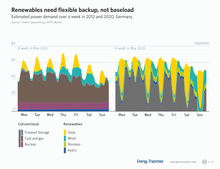Base load

Thebase load[2](alsobaseload) is the minimum level of demand on anelectrical gridover a span of time, for example, one week. This demand can be met by unvarying power plants,[3]dispatchable generation,[4]or by a collection of smallerintermittent energy sources,[5]depending on which approach has the best mix of cost, availability and reliability in any particular market. The remainder of demand, varying throughout a day, is met by dispatchable generation which can be turned up or down quickly, such asload following power plants,peaking power plants,orenergy storage.
Power plants that do not change their power output quickly, such as some large coal or nuclear plants, are generally calledbaseload power plants.[3][6][7]In the 20th century most or all of base load demand was met with baseload power plants,[8]whereas new capacity based around renewables often employs flexible generation.[9]
Description
[edit]Grid operatorstakelong and short term bidsto provide electricity over various time periods andbalance supply and demandcontinuously.[10]The detailed adjustments are known as theunit commitment problem in electrical power production.[citation needed]
While historically large power grids used unvarying power plants to meet the base load, there is no specific technical requirement for this to be so. The base load can equally well be met by the appropriate quantity ofintermittent power sourcesanddispatchable generation.[4][5]
Unvarying power plants can be coal, nuclear,combined cycleplants, which may take several days to start up and shut down,[11]hydroelectric,geothermal,[12]biogas,biomass,solar thermal with storageandocean thermal energy conversion.
The desirable attribute ofdispatchabilityapplies to some gas plants and hydroelectricity. Grid operators also usecurtailmentto shut plants out of the grid when their energy is not needed.[13][14]
Economics
[edit]
Grid operators solicit bids to find the cheapest sources of electricity over short and long term buying periods.[15]
Nuclear and coal plants have very highfixed costs,highplant load factor[16]but very lowmarginal costs.[citation needed]On the other hand, peak load generators, such asnatural gas,have low fixed costs, low plant load factor and high marginal costs.[17]
Some coal and nuclear power plants do not change production to match power consumption demands since it is sometimes more economical to operate them at constant production levels, and not all power plants are designed for it. TheIEAhas suggested that coal power plants should not run as baseload, because thatemits a lot of carbon dioxide,whichcauses climate change.[18]Some nuclear power stations, such as thosein France,are physically capable of being used asload following power plantsand do alter their output, to some degree, to help meet varying demands.[19][moved resource?][20][moved resource?]
Some combined-cycle plants usually fuelled by gas, can provide baseload power,[21][need quotation to verify][obsolete source]as well as being able to be cost-effectively cycled up and down to match more rapid fluctuations in consumption.
According toNational Grid plcchief executive officerSteve Hollidayin 2015, and others, baseload is "outdated".[9][7]By 2019,Steve Hollidayhad left his position as CEO ofNational Grid plcand went on the record to say that, "It’s hard to conceive that nuclear does not have an important role to play"[22]
See also
[edit]- Capacity factor
- Energy demand management
- Grid energy storage
- Load balancing (electrical power)
- Smart grid
- Load following power plant
- Peaking power plant
References
[edit]- ^Szondy, Borbála; Bodnár, Balázs; Grossetête, Alain; Gain, Thibaut; Aszódi, Attila (2024)."Review of solutions developed for improving maneuvering flexibility in German, French and Russian PWRs targeting to explore future possibilities for the new VVER-1200 nuclear power plant units in Hungary".Nuclear Engineering and Design.419.Bibcode:2024NuEnD.41912965S.doi:10.1016/j.nucengdes.2024.112965.
- ^"Definition of" baseload "".www.merriam-webster.com.Merriam Webster Dictionary.Retrieved2018-12-02.
- ^abDonald G. Fink, H. Wayne Beatty (ed),Standard Handbook for Electrical Engineers,Eleventh Edition, Mc-Graw Hill, 1978ISBN9780070209749,pp. 12-16 through 12-18
- ^abPeters, Roger, Cherise Burda (2007-09-01)."The Basics on Base Load: Meeting Ontario's Base Load Electricity Demand with Renewable Power Sources"(PDF).Pembina Institute.Retrieved2018-05-16.
{{cite web}}:CS1 maint: multiple names: authors list (link) - ^abArcher, Cristina L.; Jacobson, Mark Z. (November 2007). "Supplying Baseload Power and Reducing Transmission Requirements by Interconnecting Wind Farms".Journal of Applied Meteorology and Climatology.46(11): 1701–1717.Bibcode:2007JApMC..46.1701A.CiteSeerX10.1.1.475.4620.doi:10.1175/2007jamc1538.1.ISSN1558-8424.
- ^"Energy Dictionary - Baseload plant".EnergyVortex.com. Archived fromthe originalon 2009-02-15.Retrieved2008-08-03.
- ^abJuly 10; Alum, 2017 Kevin Steinberger-Alum Miles Farmer-."Debunking Three Myths About" Baseload "".NRDC.Retrieved2022-01-29.
{{cite web}}:CS1 maint: numeric names: authors list (link) - ^"The Baseload Fallacy".Energy Global.2023-08-02.Retrieved2024-04-07.
- ^abKarel Beckman (11 September 2015)."Steve Holliday CEO National Grid: baseload is outdated".EnergyPost.eu.Archivedfrom the original on 10 September 2016.Retrieved6 October2016.
- ^Maurer, Luiz T.A., Luiz A. Barroso (2011).Electricity Auctions: An Overview of Efficient Practices(PDF).World Bank Publications.ISBN978-0-8213-8822-8.
{{cite book}}:CS1 maint: multiple names: authors list (link) - ^Nelder, Chris."Why baseload power is doomed".ZDNet.Retrieved2018-12-02.
- ^"Scaling Geothermal for Reliable Baseload Power".renewableenergyworld.com. 2007-10-05. Archived fromthe originalon 2018-07-01.Retrieved2008-08-03.
- ^Bird, Lori; Lew, Debra; Milligan, Michael; Carlini, E. Maria; Estanqueiro, Ana; Flynn, Damian; Gomez-Lazaro, Emilio; Holttinen, Hannele; Menemenlis, Nickie (November 2016)."Wind and solar energy curtailment: A review of international experience".Renewable and Sustainable Energy Reviews.65:577–586.doi:10.1016/j.rser.2016.06.082.ISSN1364-0321.
- ^GIMON, ERIC, ROBBIE ORVIS AND SONIA AGGARWAL (2015-03-23)."Renewables Curtailment: What We Can Learn From Grid Operations in California and the Midwest".Green Tech Media.Retrieved2018-05-16.
{{cite web}}:CS1 maint: multiple names: authors list (link) - ^Johnston, David Cay (2014-05-29)."OPINION: How electricity auctions are rigged to favor industry".Al Jazeera.Retrieved2018-05-16.
- ^"What is Generation Capacity?".Energy.gov.Retrieved2022-06-18.
- ^Ronald J. Daniels (1996).Ontario Hydro at the Millennium: Has Monopoly's Moment Passed?.Montreal and Kingston: McGill-Queen's University Press.ISBN9780773514300.Retrieved2008-08-03.
- ^"Accelerating Just Transitions for the Coal Sector – Analysis".IEA.2024-03-19.Retrieved2024-04-06.
- ^Nuclear Development, June 2011, page 10 fromhttp://www.oecd-nea.org/
- ^"Nuclear Development".www.oecd-nea.org.Nuclear Energy Agency.Retrieved2018-12-02.
- ^"A user's guide to natural gas power plants".Utility Dive.Retrieved2022-06-18.
- ^Stanley Reed (7 January 2019)."For Wales, Nuclear Plant Would Mean New Jobs. For the U.K., It May Mean More".New York Times.

